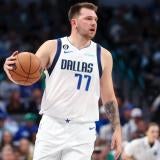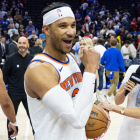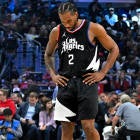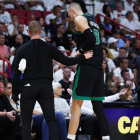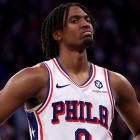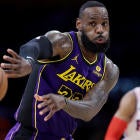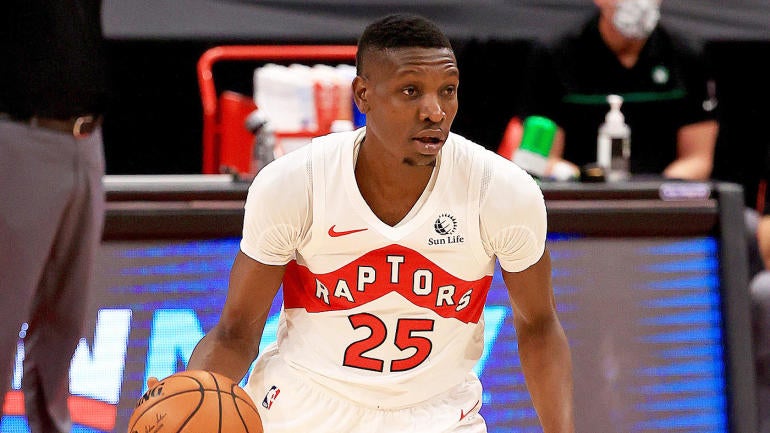
"Role player" is not an insult, nor is it a permanent label. Many of today's All-Stars are yesterday's 3-and-D guys, and behind every story about a max player reaching new heights is an improved cast of supporting characters lifting him there.
None of these eight players will make the All-Star team this season, but they've all been indispensable to their respective teams. Let's start with a 25-year-old rookie who spent last season in Australia.
Note: All stats reflect games played before Jan.18.
Jae'Sean Tate, Houston Rockets
Stephen Silas was impressed from the beginning. In training camp, the Houston Rockets coach promised that fans would enjoy watching Tate, an "exciting player" who had spent the first two years of his professional career with the Antwerp Giants and Sydney Kings. It was already clear to Silas that the 6-foot-4 Tate was strong enough to defend taller players. He could set solid screens. He could put the ball on the floor. It turns out, though, that Tate is even more versatile than that.
"I didn't expect to have a point forward on my roster," Silas said Sunday.
The day after the James Harden trade, only four Rockets were available to play against the San Antonio Spurs. John Wall was out with a sore knee. Eric Gordon was out with a leg injury. Chris Clemons' season had ended when he tore his Achilles in an exhibition game. Thirty seconds in, Tate hit Keldon Johnson with a right-to-left crossover off a handoff, powered his way to the rim and scored off the glass. On Houston's next offensive possession, Tate brought the ball up, ran a pick-and-roll and picked up his first assist. He finished with 13 points, 10 assists, five rebounds, two blocks and plus-17 in his 33 minutes. After the 109-105 win, Silas compared him to Anthony Mason.
Tate's swing skill was supposed to be 3-point shooting, and if he is going to carry P.J. Tucker's torch he obviously needs to improve his 25 percent mark. The wild thing is that he has earned his spot anyway, a credit to his assortment of other skills.
Tate loves to drive left, and he has an enviable combination of explosiveness, fearlessness and touch. He has already dunked on Nikola Jokic and finished over Anthony Davis and LeBron James, separately:
He has some post game:
And his ability to move the ball and make quick decisions is even more valuable in a post-Harden world, where Silas wants the Rockets to play faster, with more flow. Tate didn't duplicate his double-double in their rematch against the Spurs on Saturday, but when Ben McLemore backcut Dejounte Murray, he fired this picture-perfect bounce pass:
The reason Tate's on/off numbers look good, though, is his defense. Tate is a wrecking ball, capable of staying in front of star guards and wrestling with bigs. Here he's forcing Luka Doncic to turn it over, first applying pressure then moving his feet and, finally, pulling the chair:
And here he is forcing Damian Lillard baseline, absorbing contact, avoiding a foul and using his length to cause a turnover:
During the debacle that was Harden's finale, Tate stripped LeBron James in transition and, down 25 in the fourth quarter, refused to let Montrezl Harrell get an easy post touch. In crunch time of the San Antonio game, he tied up the aforementioned Keldon Johnson, one of the most aggressive drivers I've ever seen. He took Rudy Gay by complete surprise with a weakside block in the second game:
Tate is an oddball, the kind of player that allows his coaching staff to experiment with crazy lineups. If you've caught the Rockets at the right time, you might have already seen him at "center." On Jan. 2, they were in a back-and-forth game against the Sacramento Kings until Tate, Gordon, David Nwaba, Sterling Brown, Danuel House Jr. and Tate -- five guys ranging from 6-3 to 6-6, all between 215 and 230 pounds -- went on a run at the beginning of the fourth quarter. Harden was out with a sprained ankle that night. We should see more of this.
Chris Boucher, Toronto Raptors
Whenever Boucher shoots, I expect the ball to find its way to the bottom of the net. I expect this even if -- especially if! -- the Toronto Raptors are in the middle of one of their dispiriting droughts, Boucher has just checked into the game and the shot isn't particularly open. While his team has had a thoroughly strange, slightly cursed time in Tampa Bay, Boucher seems to have existed in a different universe, unbothered by the relocation, the record and the rest of it.
For Toronto, the twin departures of Marc Gasol and Serge Ibaka have been punishing, as have the relative struggles of Pascal Siakam (the past couple of weeks have been much better), Norman Powell (hey, two efficient games in a row!) and Aron Baynes (still waiting). For Boucher, all of this has afforded him playing time and a chance to stand out.
In his way, Boucher was already a sight to behold last season, occupying the space between an energy guy and a unicorn. A stretch 5 in the most literal sense, his arms are so long that he routinely blocks 3s, his release point so high that it'll never happen to him. His game -- blocking shots, shrinking passing lanes, running the floor, shooting 3s with no conscience -- hasn't changed, exactly, but he's better at everything. Per 36 minutes, Boucher is averaging 24 points, 10.3 rebounds, 3.8 blocks, 0.9 steals and (a career-low!) 4.5 fouls. His PER (29.07, second in the entire league), true shooting percentage (72.2 percent) and 3-point percentage (47.7 percent) are preposterous. By net rating, the Raptors have been slightly better than they were last season with him on the court and just about as bad as last year's Cleveland Cavaliers with him on the bench.
"He's got that thing that you can't see, you don't really know what it is," Toronto's Fred VanVleet said last week. "But he's just got a great feel and just a great gamble about him where he makes risky plays, he takes chances and they work out for him more than they don't. So he doesn't have a textbook jump shot, he doesn't have the quote-unquote best frame that you would want on a big guy and he just figures it out, man. He's just a baller. He plays basketball, he's a great basketball player and if you were creating a player I don't think it would come out looking like Chris in any shape or form but I would take him on my team any day if I needed to win a ball game."
VanVleet also noted that Boucher has been "carrying us offensively a lot throughout quarters." While this is a stunning thing to say about a player who averaged a career-high 6.6 points last season and warmed the bench in the playoffs, it is unequivocally true. As a rule, NBA players don't break out at the age of 28, but they also don't start playing organized basketball at 19. Nothing about Boucher is conventional.
De'Andre Hunter, Atlanta Hawks
Coming into the season, it was reasonable to wonder about Hunter's role. Minutes aren't gifted to second-year players on teams that have better options and are trying to make the playoffs. With Danilo Gallinari and Bogdan Bogdanovic in the picture, it no longer mattered that Hunter was the fourth pick in the draft. It didn't matter that Cam Reddish was the 10th pick, either. Would there even be room in the rotation for both of them?
Four weeks in, that seems laughable. Hunter has started every game and played only 13 fewer minutes than Trae Young, the only other Hawk averaging more than 30 minutes per game. John Collins presciently called Hunter a "super glue guy" during the preseason, an appropriate name for a player who has held Atlanta's lineups together while Gallinari, Rajon Rondo, Kris Dunn and Onyeka Okongwu have barely played. Bogdanovic injured his knee a week and a half ago.
Hunter looked the part of a 3-and-D wing as a rookie, but he usually seemed to be going too fast on offense and reacting too slowly on defense. Now he has found his tempo. He makes the simple, correct read more often than not, and he's making 41 percent of his catch-and-shoot 3s. His efficiency is way up across the board. He's often the Hawks' nominal power forward, but he's also the guy Lloyd Pierce puts on Kyrie Irving. Even his rebounding has improved.
That Atlanta has stayed afloat is a credit to Hunter and center Clint Capela, the two players most responsible for its better-than-expected defense. The Hawks' most-used lineup is Young-Reddish-Hunter-Collins-Capela, which has a plus-13.1 net rating and has been elite defensively. It still seems like managing the rotation will be a delicate balancing act when they're at full strength, but Hunter's spot is secure.
Nicolas Batum, Los Angeles Clippers
The Los Angeles Clippers want the world to know that everything feels different. Their energy is way better, their chemistry is amazing, They fell apart in last year's playoffs, sure, but that won't happen again.
We'll see. One thing that is definitely new, though, is their starting lineup. They moved Ivica Zubac to the bench in favor of much-ballyhooed offseason signing Serge Ibaka and moved Marcus Morris to the bench in favor of Nicolas Batum, whose arrival in Los Angeles was barely ballyhooed at all. The new starters have a plus-22.7 net rating, an incredible number that is almost identical to the old group's. Ibaka allows them to play five-out under new coach Tyronn Lue, and Batum works so beautifully as a low-usage gap-filler that we should all be retroactively mad that he spent last season chilling in Charlotte.
At 32, in his 13th year, Batum has never shot more efficiently. He has made 45.5 percent of his catch-and-shoot 3s, and, because he's next to two superstars and the floor is spaced, he's still getting a steady diet of wide-open looks. It is unlikely that he will remain near the top of FiveThirtyEight's player rankings -- Batum is currently 8th in WAR and 13th in RAPTOR -- but, even if he cools off, his mere presence could help the Clippers in their quest for harmony.
It turns out that Batum is still a versatile defender. In this context he is more of a spot-up guy and ball mover than the point forward he used to be, but he has undeniably helped the Clippers play with more flow in the halfcourt. They were third from the bottom in passes per game (271) last season, per NBA.com, and now they're up to 18th (288), a healthy jump for a team that can score so easily in isolation. With more room to operate, Paul George is playing like the MVP candidate he was two seasons ago.
Did the Clippers collapse because of bad shooting luck? Because the coaching staff didn't make the right adjustments? Because the players didn't get along well enough? Because they didn't practice frequently? Because the hiatus disrupted their rhythm and the bubble broke their spirit? Maybe it's all of that, but maybe, as talented as they were, they needed a bit more connective tissue on the court. After they lost Game 7 to the Denver Nuggets, Kawhi Leonard said they needed to "get smarter as a team." No one knew Batum had this much in the tank when the Cilppers signed him, but there has never been any doubt about his basketball IQ.
Damion Lee, Golden State Warriors
Lee hit a game-winning 3 on Dec. 27, saving the Golden State Warriors from an 0-3 start. More significant than the shot, though, was that coach Steve Kerr kept him on the court for the entire fourth quarter, save for an offense-defense substitution on the play that preceded his big moment. Lee played the whole fourth in the Warriors' comeback victory against the Clippers on Jan. 8, too, and Kerr put him in when they were desperate for crunch-time scoring against the Raptors two days later. With 4.3 seconds left, Kyle Lowry fouled him on a jump shot and Lee made the free throws that sealed the win.
Context is everything in the NBA. The Warriors' starting unit has been awful offensively, with opposing teams daring anybody but Stephen Curry to make jumpers, and fans have been clamoring for Lee to replace Kelly Oubre Jr. for weeks. Fifty-five percent of Lee's field goal attempts have been above-the-break 3s, per Cleaning The Glass, and he has made 43.2 percent of his catch-and-shoot 3s.
Lee can punish traps and box-and-one defenses designed to get the ball out of Curry's hands. Here, with his defender among three Clippers worried about Curry in transition, he swishes one from the wing:
His release is quick and easy. Lee is not a Splash Brother, but, as a Splash Brother-in-Law, he can relocate on the perimeter and square up:
He doesn't get to it often, but when opponents run him off the line, he has a pretty floater in his arsenal:
For a team built around the greatest shooter who has ever lived, Golden State has an alarming problem with floor spacing. Curry has been phenomenal this season, but Golden State has a minus-14.7 net rating in the minutes he's played next to Oubre, Andrew Wiggins and James Wiseman, per CTG, and he has spent 44.2 percent of his total minutes with that trio. The Warriors have been at their best when Curry runs with the bench, and they have a plus-15.7 net rating with him and Lee in the backcourt.
There's a good chance you've seen the clip of Bob Myers explaining the difference between playoff basketball and regular-season basketball at the 2019 Sloan conference. Myers says that shooters can be neutralized when the "two feet of space you have in the regular season is two inches." Lee has yet to face playoff scrutiny, but if the Warriors want to get there, they might need to play him more than 19 minutes a game in the regular season. The best argument for keeping him out of the first five is that the second unit needs his shooting, too.
Desmond Bane, Memphis Grizzlies
To survive without Ja Morant (and Jaren Jackson Jr. and Justise Winslow), the Memphis Grizzlies needed Dillon Brooks and Kyle Anderson to make more plays. They needed their team defense to keep them in games. Just like last season, though, they were able to overachieve because of their bench. The Grizzlies went 4-4 without Morant, a stretch in which their most-used lineup -- the starting unit of Tyus Jones, Brooks, Anderson, Brandon Clarke and Jonas Valanciunas -- had a minus-13.9 net rating. Their bench, however, ranked 10th in the league, and the guy they selected with the No. 30 pick in the draft has a lot to do with it.
Desmond Bane has been exactly as advertised as a pro. His shooting (so far he's making 56.5 percent of his wide-open 3s and 51.4 percent of his catch-and-shoot 3s) is particularly valuable for the same reason Lee's has been so important to Golden State. Everybody on Memphis' roster shoots 3s, but outside of Bane, Grayson Allen and the injured Jackson, no one has much gravity. The Grizzlies' halfcourt offense has been almost 10 points per 100 possessions better with Bane on the court than with him on the bench, per CTG.
But there is more to Bane than spot-up shooting. While he is not in attack mode nearly as frequently, his herky-jerky forays to the basket and pull-up jumpers bring to mind a young Eric Gordon:
He's a good decision-maker and makes the kind of passes that suggest he'll grow into more of a playmaking role:
And he fits right in on a team that likes to switch:
Bane is one of the strongest wings in the league, and he might not be the strongest rookie on his own team -- the immovable Xavier Tillman almost made this list, too. Morant is back now. Watch the Grizzlies!
Willie Cauley-Stein, Dallas Mavericks
As a roller, Cauley-Stein catches everything, finishes almost everything and absolutely must be accounted for. You think someone like that would work well with Luka Doncic?
Cauley-Stein has insane on/off numbers, and the Mavericks have a plus-17.2 net rating with him and Doncic on the court. The threat of the alley-oop creates shots for Dallas' shooters, and Cauley-Stein's speed in transition generates easy buckets, too. Between this, his knack for putbacks and the Mavs being a better defensive team with him on the court, Rick Carlisle had all sorts of reasons to make him their starting center a couple of weeks ago.
"It isn't just numbers," Carlisle told reporters, noting that Cauley-Stein played so hard in his first stint as a starter that he asked to come out after about five minutes. "You're looking at work habits, you're looking at personality in terms of commitment to team and those kinds of things. Look, he's checking a lot of boxes."
Cauley-Stein's block and steal rates are lower than they have been in previous seasons, but he's no less of a presence on defense. With less than a minute remaining against the Milwaukee Bucks last Friday, he switched onto Jrue Holiday and stopped him one-on-one:
On the offensive end, Cauley-Stein has all but eliminated the floaters and midrange jumpers he used to take on a semi-frequent basis. He has always seen himself as more than a Tyson Chandler type, but sometimes accepting a smaller role is good for business.
Cameron Payne, Phoenix Suns
The sample size is increasing and very little is changing. After a charmed run with the Phoenix Suns in the bubble, Payne has continued his renaissance. Payne is averaging 15.5 points, 8.8 assists, 5.0 rebounds and 1.4 steals per 36 minutes as Chris Paul's backup.
The Suns are blowing teams out in Payne's minutes, and they're forcing turnovers like crazy when they play him next to Jevon Carter and Langston Galloway. He hasn't been quite as scorching as he was in the bubble, but he's still on fire: 59.7 true shooting, 42.9 percent from deep. Look at these off-the-dribble 3s:
Payne is crafty and patient in the pick-and-roll, which leads me to my favorite obscure stat of the season: On a per-possession basis, no one has assisted more 3-pointers than Payne. (He is generating 7.21 3s per 100 possessions, per PBPstats. Russell Westbrook are Ben Simmons round out the top three.)
Payne also averages 4.39 assists at the rim per 100 possessions, which ranks 14th, ahead of Westbrook, LeBron and Paul.
The Suns' earned rave reviews for their offseason, but it looks like one of their most meaningful moves was made last June. Payne had been lighting it up in the G League, and they signed him to a two-year minimum contract, with an almost fully non-guaranteed second season. For them, it was a low-risk flier on a former lottery pick. For him, it was a high-stakes chance to show he belongs. Next summer Payne will be a free agent again, and his experience will be nothing like that.
Other notable supporting characters: Call him FIBA Patty, Aggressive Patty, whatever you like -- Patty Mills is perfect for the Seven Seconds or Less Spurs, jacking 3s, making most of them and destroying opposing teams' second units … Terrence Ross has responded to every team running him off the line by taking fewer 3s and more 2s, and he's never been more efficient … Jordan Clarkson is a scoring machine … I love every part of the Talen Horton-Tucker experience, even when he's not in the rotation and Kendrick Perkins is claiming the Lakers are conspiring against him … Trey Burke still looks good in Dallas' system, especially because he is making his catch-and-shoot 3s … The Bulls desperately needed someone like Garrett Temple to connect the dots … Thaddeus Young looks like himself again under Billy Donovan … John Konchar remains an advanced-stats legend … Considering the source, JaMychal Green earned himself one of the best compliments ever.







